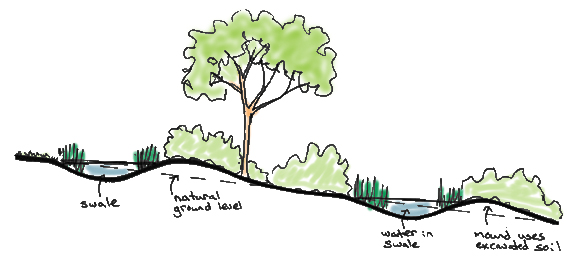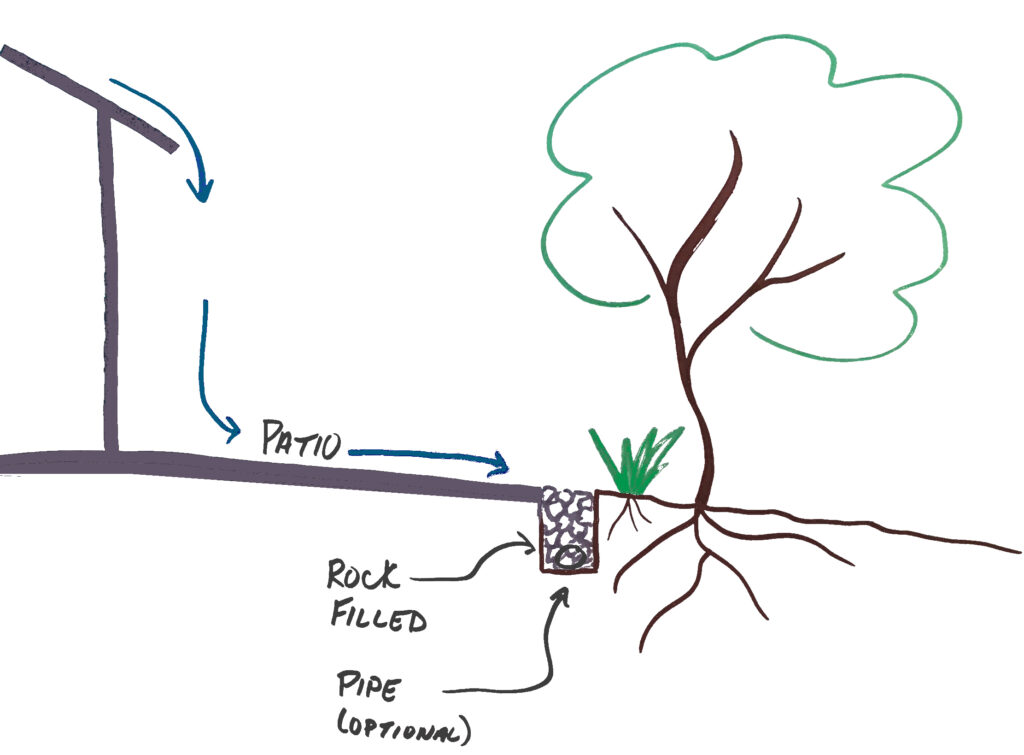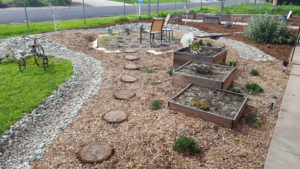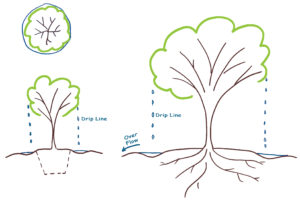Rain in many places has become it’s own phenomenon…in that it doesn’t happen much…or it pours! But whether you live in a dry area, or a fairly wet area, rain is a commodity that should not be overlooked. According to the 2016 Crop Report in our part of the central California Valley we get, on average, 12 inches of rain, sometimes more, sometimes MUCH less. But if we use that 12″ average, we get the following numbers:
1 inch of rain = 62 gallons/100 s.f. (that’s a 10′ x 10′ space)
12 inches of rain = 748 Gallons/Year/100 s.f. …that’s 325,654 Gallons/Year/Acre (43,560 s.f.)
Unfortunately, home sites are designed to drain all that water to the street and down the gutter. While we can’t possibly catch and store all the rain that falls on our site, we certainly want to keep as much of it as possible…and put it to good use getting our plants the water they need when they expect to get it the most (the winter). This is especially true for native and drought tolerant plants. Water in the winter is crucial, and you can’t make up for it in the summer (and if you try…you may kill your plants).
So, how do we do it? Here are some simple things you can do in your yard that can not only help you Slow, Spread, and Sink rainwater, but can also be used as design features to liven up your yard.

Swales
Swales are small catchments constructed on contour (meaning they follow a grade line so as to catch, and not drain, water). Plant plants on the downhill side of the constructed berm and your plants benefit from the water that is caught. Line with rock or fill with mulch (realize mulch filled ones will need maintenance every couple of years as the mulch breaks down). Click on the image to learn more about swales.

French Drains
Walkable and invisible, these drains are ideal for moving water away from sediment free zones (e.g. patios). These drains are filled with rock to allow water to move from the surface. A perforated pipe can be placed at the bottom to catch and move the water. If using a pipe be careful no to place plants too close as they will eventually clog the line.
If you do choose to use them in a less than permanent surface, it is suggested to cover the pipe with a filter cloth, and you may even want to place a cloth near the top of the ground opening.

Dry Creeks
These are a low maintenance way to catch and move water. Rock lined, these do not break down and therefore require little maintenance…mostly weed removal on occasion and leaf removal in the fall. These are quite possibly my favorite type of rainwater harvesting as they are also a great design feature in your yard and can be used as edges to define different spaces.

Tree Wells
These should be done not only for rainwater, but are a great way to water your tree if you are unable to use drip and are only watering with a hose at it creates a catchment all around your tree. The diagram to the right shows how a tree well works and where it shoudl be placed. Note that the well gets bigger as the tree gets bigger. If you are installing a new yard and don’t want to come back to these for some time you can do the initial well and second well at the approximate full size diameter (ideally if you are covering with mulch).
Wells should never be designed such that the base of the tree trunk gets wet. This will eventually rot out your trunk. The trunk of the tree should be just enough above grade so that the excess water flows away from, rather than toward, the tree.

Vegetable Gardens
The method of waffle gardening has been used for centuries. It creates a waffle grid, where paths are raised and planting areas are low.
The Keyhole garden is similar, with a main center path, and raised kneeling areas where you can reach all the plants. This method holds water while also maximizing planting area.
You can vary these concepts any way you want, just remember the goal, keep water where the the plants are…not your feet. Also make sure the water doesn’t stick around any period of time, or it will rot your plants. Plants can also be planted on small hills to keep their feet from getting too wet.
The Process
- Observe
- Start Small
- Spread and Infiltrate Flow
- Plan for Overflow
- Reassess System
Adapted from Harvesting Rainwater by Brad Landcaster
Rules of Thumb & Technical
- Keep catchments away/downhill from your septic
- Your local County or City Planning Office can provide As Built Septic records upon request
- Rain Water Catchment Calculation
- How to Build an A-Frame – for grading non-linear swales and washes

Comments are closed.